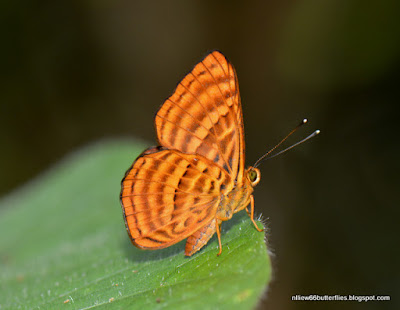In flight and afar, it looks like an orange version of the Z. flegyas (Punchinello) and can be found in the same localities. They all have the same habits of settling with wings half-opened and often restless, making them a difficult subject to photograph.
Habitat indicator
RSP
|
WV
|
PG
|
VF
|
FTR
|
SC
|
LWDF
|
LWPF
|
LMEF
|
UMN
|
MN
|
x
|
x
|
Frequency observation chart: (S marks the usual occurences, H marks an unusually high occurence, F for first record)
2013
| |||||||
Mac
|
Apr
|
May
|
Jun
|
Jul
|
Aug
|
Sep
|
Oct
|
S3
| |||||||
2013
|
2014
| ||||||||||
Nov
|
Dec
|
Jan
|
Feb
|
Mac
|
Apr
|
May
|
Jun
|
Jul
|
Aug
|
Sep
|
Oct
|
| S2 | S2 | S2 | S3 | ||||||||
2014
|
2015
| ||||||||||||
Nov
|
Dec
|
Jan
|
Feb
|
Mac
|
Apr
|
May
|
June
|
Jul
|
Aug
|
Sep
|
Oct
|
Nov
|
Dec
|
S7
|
S1S2
|
S2
|
S2
|
S2
|
S11
| ||||||||
2016
|
|||||||||||
Jan
|
Feb
|
Mac
|
Apr
|
May
|
Jun
|
Jul
|
Aug
|
Sep
|
Oct
|
Nov
|
Dec
|
S2
|
S2
|
S2
|
|||||||||
2017
|
|||||||||||
Jan
|
Feb
|
Mac
|
Apr
|
May
|
Jun
|
Jul
|
Aug
|
Sep
|
Oct
|
Nov
|
Dec
|
S5
|
S5
|
||||||||||
















Glad to find your blog. a very good reference to the butterflies in peninsular malaysia.
ReplyDelete